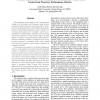Free Online Productivity Tools
i2Speak
i2Symbol
i2OCR
iTex2Img
iWeb2Print
iWeb2Shot
i2Type
iPdf2Split
iPdf2Merge
i2Bopomofo
i2Arabic
i2Style
i2Image
i2PDF
iLatex2Rtf
Sci2ools
HPCA
2009
IEEE
2009
IEEE
Versatile prediction and fast estimation of Architectural Vulnerability Factor from processor performance metrics
The shrinking processor feature size, lower threshold voltage and increasing clock frequency make modern processors highly vulnerable to transient faults. Architectural Vulnerability Factor (AVF) reflects the possibility that a transient fault eventually causes a visible error in the program output, and it indicates a system's susceptibility to transient faults. Therefore, the awareness of the AVF especially at early design stage is greatly helpful to achieve a trade-off between system performance and reliability. However, tracking the AVF during program execution is extremely costly, which makes accurate AVF prediction extraordinarily attractive to computer architects. In this paper, we propose to use Boosted Regression Trees, a nonparametric tree-based predictive modeling scheme, to identify the correlation across workloads, execution phases and processor configurations between a key processor structure's AVF and various performance metrics. The proposed method not only ma...
Accurate Avf Prediction | Computer Architecture | HPCA 2009 | Processor Feature Size | Various Performance Metrics |
| Added | 25 Nov 2009 |
| Updated | 25 Nov 2009 |
| Type | Conference |
| Year | 2009 |
| Where | HPCA |
| Authors | Lide Duan, Bin Li, Lu Peng |
Comments (0)

